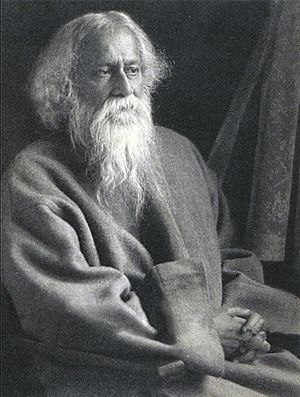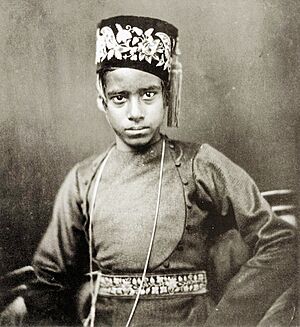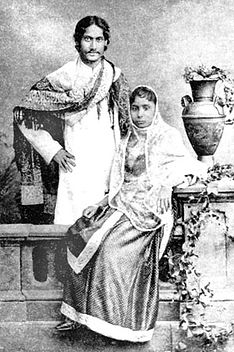Rabindranath Tagore facts for kids
Quick facts for kids
Rabindranath Tagore
FRAS
|
|
|---|---|

Tagore (c. 1925)
|
|
| Native name |
Robindronath Thakur
|
| Born | 7 May 1861 Calcutta, British India |
| Died | 7 August 1941 (aged 80) Calcutta, British India |
| Resting place | Cremated at Nimtala crematorium, Calcutta, British India; Ashes scattered in the Ganges River. |
| Pen name | Bhanu Singha Thakur (Bhonita) |
| Occupation | |
| Language | |
| Nationality | British Indian |
| Alma mater | University of Calcutta |
| Period | Bengal Renaissance |
| Literary movement | Contextual Modernism |
| Notable works |
|
| Notable awards | Nobel Prize in Literature 1913 |
| Spouse |
Mrinalini Devi
(m. 1883–1902) |
| Children |
|
| Relatives | Tagore family |
| Signature | |
Rabindranath Tagore (Bengali: রবীন্দ্রনাথ ঠাকুর) was a famous Indian writer, poet, and artist. People often called him "Kabiguru," which means "Master Poet." He was born on May 7, 1861. His name is sometimes written as Rabindranath Thakur.
Tagore wrote many stories, novels, poems, and plays. He also composed a lot of music. His work greatly shaped Bengali culture in the late 1800s and early 1900s. In 1913, he made history by becoming the first Asian person to win the Nobel Prize in Literature.
Some of his most famous works include Gitanjali (Song Offerings), a well-known poetry book. He also wrote the novels Gora (Fair-Faced) and Ghare-Baire (The Home and the World). Tagore was also a cultural reformer. He helped modernize Bengali art by using new forms and styles.
Rabindranath Tagore passed away on August 7, 1941.
Contents
Growing Up (1861–1878)
Tagore was born in Kolkata (formerly Calcutta), India. He grew up in a place called Jorasanko Thakur Bari. He was the youngest of 14 children. His father was Debendranath Tagore, and his mother was Sarada Devi.
Tagore was from a Bengali Brahman family. His family nickname was "Rab" or "Rabi." He started writing poems at just eight years old. By age 16, he had published his first big poetry book. He also wrote his first short story and plays around this time.
In 1873, when he was 11, Tagore traveled across India with his father. They visited places like Amritsar and the Himalayas. He also saw his father's estate in Shantiniketan. During this trip, he read biographies and studied history, astronomy, and science. He also read works by famous ancient poets.
Tagore also wrote many literary pieces during this time. He even wrote a long poem in Maithili, a language spoken in Mithila, India. He wrote it in the style of Vidyapati, a famous Maithili poet.
Life and Family (1878–1900)
In 1878, Tagore went to London, England. He studied at a school in Brighton. He wanted to become a lawyer. Later, he attended University College London. However, in 1880, his father called him back to India because he wasn't doing well in school.
His father arranged for him to marry Mrinalini Devi, who was ten years old. Child marriage was common back then. They married on December 9, 1883. They had five children together, but two of them sadly died young.
In 1890, Tagore started managing his family's estates in Sheildah, which is now in Bangladesh. His wife and children joined him there in 1898. Tagore traveled all over the large estate. From 1891 to 1895, he wrote many short stories. These stories often showed what life was like in rural Bengal.
Building Shantiniketan (1901–1932)
In 1901, Tagore left Sheildah and moved to Santiniketan in West Bengal. He wanted to build an ashram there. An ashram is like a peaceful spiritual center. "Shantiniketan" means "an abode of peace" in English. He built a prayer hall, a school, and a library. He also planted many trees and created a garden.
Sadly, Tagore's wife and two of his children passed away in Shantiniketan. His father also died in 1905.
By this time, Tagore started receiving money from his family's inheritance. He also earned royalties from his books. He was very popular among Bengali readers. Many people also knew his works through translations.
On November 14, 1913, Tagore won the Nobel Prize in Literature. The Swedish Academy chose him for his poems, especially his 1912 book Gitanjali: Song Offerings.
The British government gave Tagore a knighthood in 1915. However, he gave this title back in 1919. He did this to protest the Jallianwala Bagh Massacre in Amritsar. During this event, British soldiers killed many unarmed people.
In 1921, Tagore and an agricultural expert named Leonard K. Elmhirst started a special institute. It was called the Institute for Rural Reconstruction. It was in a village near Tagore's ashram. Tagore invited scholars from many countries to help. The goal was to use education to help villages become stronger and wiser.
In the early 1930s, Tagore became more worried about India's "caste consciousness." This was about differences based on social groups. He gave talks about how bad these practices were. He also wrote many poems and plays about these issues. He became an activist for social change.
Later Years (1932–1941)
Tagore continued his activism even in the last ten years of his life. He disagreed with Mahatma Gandhi, one of India's leaders. Gandhi had said that an earthquake in Bihar in 1934 was God's punishment for casteism. Tagore did not agree with this idea.
Tagore also wrote a long poem about the poverty in Kolkata. Later, a famous filmmaker, Satyajit Ray, made a movie based on this poem.
During this time, Tagore wrote many prose-poems. These covered different parts of human life. In his final years, Tagore became interested in science. He wrote essays about biology, physics, and astronomy.
Tagore was not in good health for the last four years of his life. In 1937, he lost consciousness and was in a coma for a long time. He woke up, but three years later, he went back into a coma. When he was awake and felt well, he kept writing poems. These poems often talked about being close to death. Tagore died on August 7, 1941, at age 80. He passed away in his childhood home in Kolkata.
Travels Around the World
Between 1878 and 1932, Tagore visited 30 countries on five continents. He wanted people who didn't speak Bengali to know his literary works. He also shared his ideas, including his political thoughts.
In 1912, Tagore went to England. The famous poet William Butler Yeats wrote the introduction for the English version of Tagore's book Gitanjali. Tagore also met many other important writers there.
From May 1916 to April 1917, Tagore gave many lectures in Japan. After returning to India, he visited Peru and Mexico in 1924. Both governments promised money for Tagore's school in Shantiniketan.
In 1926, Tagore met Benito Mussolini, a dictator in Rome, Italy. However, Tagore later spoke out against Mussolini's ideas.
In July 1927, Tagore and two friends toured Southeast Asia for four months. They visited places like Bali, Java, Kuala Lumpur, and Siam. Tagore later wrote a book called Jatri (The Traveler) about these trips.
In early 1930, Tagore traveled for almost a year in Europe and the United States. His paintings were shown in Paris and London. He also gave lectures at the University of Oxford.

From June to September 1930, Tagore visited Denmark, Switzerland, and Germany. He also toured the Soviet Union.
Tagore's travels allowed him to meet many famous people. These included Albert Einstein, Robert Frost, Mahatma Gandhi, and H. G. Wells.
His last trips abroad were to Iran and Iraq in 1932, and to Sri Lanka in 1933. He visited Iran as a special guest of the Shah.
Tagore's Works
Tagore was mainly a poet, but he also wrote many other things. These include essays, short stories, travel books, plays, and thousands of songs. He was also a talented painter.
Many movies use songs from Tagore's collection, known as Rabindra Sangeet, as their soundtracks.
Tagore also wrote many non-fiction books. These covered topics like Indian history, languages, his travels, and his own life story.
Music and Art
Tagore was a musician and painter. He wrote about 2,230 songs. People call these "Rabindra Sangeet," meaning "Tagore Song." These songs are a big part of modern Bengali culture. Many of his poems and songs are found in his novels and stories.
His songs express many human feelings, from devotion to love. In most Bengali-speaking families, people still sing Rabindra Sangeet.
Tagore is the only person in the world to have written the national anthems for two countries. These are Bangladesh's Amar Shonar Bangla and India's Jana Gana Mana.
At age 60, Tagore started drawing and painting. He used many different styles from around the world. Sometimes, he used his own handwriting in artistic ways on his papers. His drawings and paintings were shown in France and London.
Plays
When Tagore was 16, he acted in a play organized by his brother. At age 20, he wrote a play called Valmiki Pratibha (The Genius of Valmiki). This play told the story of Valmiki, a robber who became a wise person and wrote the Ramayana.
Another famous play is Dak Ghar (The Post Office). It's about a child who tries to escape his room and falls asleep, which suggests death. This play was well-received in Europe. In 1890, he wrote Visarjan (Sacrifice), which many think is his best play. Tagore wrote his plays to show "the play of feeling and not of action."
Short Stories
Tagore wrote many short stories. Galpaguchchha (Bunch of Stories) is a collection of 84 of his stories. He wrote about half of these stories between 1891 and 1895. This collection is still very popular in Bengali literature. Many movies and plays have been made from these stories.
Tagore got ideas for his stories from the world around him. He saw the lives of poor people up close when he managed his family's large land. He used different themes to explore his deep thoughts.
Poetry
Tagore's poetry is very diverse and uses many styles. He was inspired by poets from the 15th and 16th centuries, and by ancient writers. Bengali folk singers also influenced his poetry style. He wrote many poems while managing his family's estates. Many of his poems have a musical quality. They often talk about the "man within the heart" and the "living God within." Over 70 years, he kept changing his poetry style. In the 1930s, he wrote experimental poems and used modern and realistic styles.
One of his famous poems says, "all I had achieved was carried off on the golden boat; only I was left behind." Tagore is known worldwide for Gitanjali ("Song Offerings"). This is his most famous collection, and it won him the Nobel Prize.
National Anthems
Tagore is the only person to have written national anthems for three countries:
- Jana Gana Mana, the national anthem of India.
- Amar Shonar Bangla, the national anthem of Bangladesh.
- Sri Lanka Matha, the national anthem of Sri Lanka. Tagore wrote the Bengali version, and his student, Ananda Samarakoon, translated it into Sinhala.
Tagore's Political Views
Tagore's political ideas were complex. He spoke out against European rule over India. He supported Indian nationalists, who wanted India to be free. But he also criticized the Swadeshi movement, which many nationalists liked. He believed in self-help and education. He said that India needed "steady and purposeful education" instead of a "blind revolution."
Some people didn't like his ideas. In 1916, some Indians planned to kill him in San Francisco, USA. But when they met him, they argued with him instead and changed their minds. Tagore also wrote many songs praising India's fight for freedom. He returned his British knighthood to protest the 1919 Amritsar massacre. In this event, British soldiers shot many unarmed people.
Despite some disagreements with Gandhi, Tagore helped solve a dispute between Gandhi and Babasaheb Ambedkar. This dispute was about separate voting rights for "untouchables," people considered lowest in the social order. Rabindranath Tagore played a key role in India's freedom movement. He was also one of the first to talk about "Globalization."
Tagore's Educational Ideas
Tagore also had strong opinions about traditional education. In 1917, he thought of a new kind of university. He wanted to build it at Shantiniketan. Work on this new university began in 1918, and it opened on December 22, 1921. He named it Visva-Bharati University.
Tagore worked hard to raise money for the university. He traveled to Europe and the United States for this purpose. He even gave all his Nobel Prize money to the university. This university focused on guiding each student personally. Students lived close to nature, and teachers and students had a relationship like the ancient Indian gurukul system. Tagore wanted this university to be "a world center for the study of humanity." He wanted it to be "somewhere beyond the limits of nation and geography."
He also had a dream for India's future. He wanted India to be free from British rule. He dreamed of an India "where the mind is without fear."
Tagore's Lasting Impact
Even many years after his death, people around the world celebrate Rabindranath Tagore. For example:
- The annual Bengali festival Kabipranam celebrates Tagore's birthday in Urbana, Illinois, USA.
- The Rabindra Path Parikrama is held in Santiniketan and other places in West Bengal. Families and cultural groups also organize events to celebrate his birthday.
Nobel Prize winner Amartya Sen, who is also Bengali, said that Tagore is still a "towering figure" for modern Bengalis. He called him a "deeply relevant and many-sided contemporary thinker."
Tagore's collected Bengali writings from 1939, called Rabīndra Rachanāvalī, are a great cultural treasure in Bengal. Tagore himself has been called "the greatest poet India has produced."
He was also famous in Europe, North America, and East Asia. His works have been translated into many languages, including Russian, English, German, and Spanish. In the United States, Tagore gave many popular lectures in 1916 and 1917.
Between 1914 and 1922, a Spanish couple translated at least 22 of Tagore's books from English into Spanish. These Spanish translations influenced many important Spanish writers. These included Pablo Neruda and Gabriela Mistral from Chile, and Octavio Paz from Mexico.
Many composers have also set Tagore's poetry to music.
See also
 In Spanish: Rabindranath Tagore para niños
In Spanish: Rabindranath Tagore para niños
Images for kids
-
Tagore's house in Shilaidaha, Bangladesh
-
Tsinghua University, 1924
-
Jawaharlal Nehru and Rabindranath Tagore
-
Tagore performing the title role in Valmiki Pratibha (1881) with his niece Indira Devi as the goddess Lakshmi.
-
Part of a poem written by Tagore in Hungary, 1926.
-
Kala Bhavan (Institute of Fine Arts), Santiniketan, India
-
Bust of Tagore in Gordon Square, Bloomsbury, London
-
Rabindranath Tagore's bust at St Stephen Green Park, Dublin, Ireland
-
Blue plaque in honor of Tagore, erected in 1961 by London County Council at 3 Villas on the Heath, Vale of Health, Hampstead, London NW3 1BA, London Borough of Camden.
-
Jorasanko Thakur Bari, Kolkata; the room in which Tagore died in 1941.
-
Tagore Room, Sardar Patel Memorial, Ahmedabad, India
























